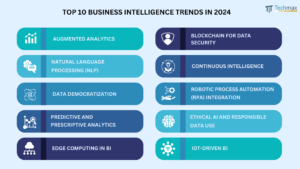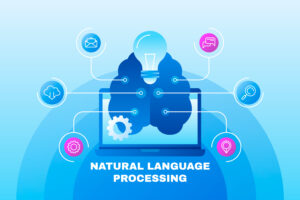As the fog of 2023 clears, the contours of 2024’s business intelligence (BI) landscape begin to sharpen. The coming year promises a dynamic and transformative journey where data ascends to the center stage, emerging not just as a tool but as the driving force behind sharper insights, democratized access, and strategic decisions that shape the future of businesses.
In the wake of unprecedented global events and technological advancements, the business intelligence field is gearing up for a paradigm shift. The narrative of 2024 is one of resilience, adaptability, and a heightened reliance on data-driven strategies. Organizations worldwide are acknowledging the pivotal role that data plays in navigating the complexities of the modern business environment.
In this unfolding scenario, BI is not merely a set of tools but a beacon guiding businesses through the data-rich landscapes of the future. 2024 is set to unveil many trends that will redefine the BI landscape, offering organizations new ways to harness the power of data for informed decision-making.
Here are the top 10 trends poised to reshape the BI landscape:

Augmented Analytics
Augmented analytics, a cutting-edge evolution in Business Intelligence (BI), seamlessly integrates machine learning and AI into analytics tools. This transformative trend is characterized by its ability to automate the generation of insights from vast datasets, effectively reducing the dependency on manual analysis and technical expertise. By harnessing machine learning, augmented analytics efficiently uncover patterns and trends, streamlining data analysis.
A key advantage is the democratization of data insights, making them accessible to non-technical users. Unlike traditional BI tools, augmented analytics leverages AI to automate complex tasks, empowering a broader range of stakeholders for faster, informed decision-making. This enhances the future of BI by improving accessibility and efficiency in data analysis.
Natural Language Processing (NLP)
Natural Language Processing (NLP) is revolutionizing Business Intelligence (BI) by enabling users to query data in everyday language, enhancing tool user-friendliness, and driving wider adoption. NLP’s ability to interpret natural language reduces the need for specialized technical skills, fostering collaboration between technical and non-technical stakeholders. This democratization of data access promotes inclusive decision-making, creating a more accessible and collaborative BI environment within organizations.

Data Democratization
Data democratization is a strategic shift toward granting individuals throughout an organization access to data, eroding traditional silos, and fostering a culture centered on data-driven decision-making. In 2024, businesses are placing a growing emphasis on empowering employees by providing self-service BI tools. This approach enables individuals to independently extract valuable insights, reducing dependency on IT teams and promoting a more agile and responsive approach to data utilization.
This trend signifies a departure from the traditional model where data access was limited to specialized IT or data teams. By implementing self-service BI tools, organizations not only break down data accessibility barriers but also cultivate a more dynamic and responsive decision-making culture. This shift allows employees across various departments to harness the power of data for informed decision-making, contributing to the overall efficiency and adaptability of the organization.
Predictive and Prescriptive Analytics
The transition from descriptive analytics to predictive and prescriptive analytics is a noteworthy trend gaining momentum in organizations. Beyond merely examining historical data, businesses are increasingly leveraging advanced analytics to forecast future trends. This shift represents a strategic move toward a more proactive and forward-looking approach to data analysis.
In this evolution, organizations are not just satisfied with understanding past performance; they are actively seeking to prescribe actions that optimize future outcomes. Predictive analytics allows businesses to anticipate potential developments, while prescriptive analytics goes a step further by recommending specific actions to achieve desired results. This shift signifies a more comprehensive and strategic use of analytics, empowering organizations to not only understand the past and predict the future but also take informed actions to shape and optimize their outcomes.
Edge Computing in BI
Edge computing is increasingly crucial in Business Intelligence (BI) as organizations prioritize processing data closer to the source. This approach aims to reduce latency and enhance real-time analytics capabilities. Anticipated in 2024 is a notable uptick in the adoption of edge computing for BI applications, particularly in industries where swift decision-making is of paramount importance.
This trend reflects a strategic move to address the limitations of centralized processing, enabling organizations to analyze data at the edge of the network where it is generated. By embracing edge computing in BI, businesses can achieve more timely insights, ultimately supporting quicker and more informed decision-making processes, a critical advantage in industries where agility and speed are key.
Blockchain for Data Security
Blockchain technology is gaining prominence in the realm of Business Intelligence (BI) as organizations prioritize data security. This technology ensures the integrity and security of data by creating a transparent and tamper-proof environment. In 2024, there is a growing adoption of blockchain in BI, driven by the need to safeguard sensitive information and adhere to stringent data protection regulations.
The integration of blockchain into BI processes enhances the overall security posture by creating an immutable and decentralized ledger for data transactions. This not only mitigates the risk of unauthorized access and tampering but also establishes a level of transparency crucial for compliance. As businesses handle increasingly sensitive data, the incorporation of blockchain in BI serves as a proactive measure to fortify data security and meet the evolving regulatory landscape.
Continuous Intelligence
Continuous intelligence is a paradigm where streaming data is analyzed in real-time, facilitating instant decision-making. In 2024, organizations are actively adopting continuous intelligence as a strategic approach to gain a competitive edge. This entails the ability to respond promptly to dynamic market conditions and evolving customer preferences, enabling businesses to stay agile and make informed decisions in a rapidly changing landscape.
Robotic Process Automation (RPA) Integration:
The integration of Business Intelligence (BI) with Robotic Process Automation (RPA) is revolutionizing data-related tasks by automating data extraction and improving workflow efficiency. This strategic trend enables organizations to seamlessly combine the analytical power of BI with the process automation capabilities of RPA, resulting in a more streamlined and agile approach to data handling.
In practice, the BI-RPA integration is proving invaluable in reducing manual efforts and mitigating errors associated with repetitive data tasks. By automating these processes, organizations can redirect human resources to more strategic aspects of data analysis, thereby optimizing overall efficiency and allowing for a sharper focus on deriving meaningful insights from the data at hand.

Ethical AI and Responsible Data Use
With the expanding integration of AI in Business Intelligence (BI), there’s a heightened focus on ethical AI practices and responsible data use. Organizations are placing a premium on transparency, fairness, and accountability within their BI processes. This strategic emphasis on ethical standards is designed not only to build trust with stakeholders but also to ensure that AI applications are deployed in a manner that respects privacy, avoids biases, and upholds principles of fairness.
IoT-driven BI
The Internet of Things (IoT) is generating vast amounts of data from connected devices. BI is leveraging this data to provide valuable insights into product performance, customer behavior, and operational efficiency. In 2024, we can expect increased integration of IoT data into BI platforms.
In conclusion, the year 2024 marks a pivotal moment for businesses as they navigate the evolving landscape of business intelligence. The top 10 trends highlighted by Techmax Technologies, from augmented analytics to IoT-driven BI, underscore a transformative journey where data takes center stage as a driving force for informed decision-making. As organizations increasingly recognize the importance of data democratization, predictive analytics, and the integration of emerging technologies like blockchain and robotic process automation, they are well-positioned to gain a competitive edge in the dynamic and data-rich future. Embracing these trends not only enhances efficiency and accessibility but also ensures ethical AI practices, fostering a culture of responsible data use. In essence, the unfolding narrative of 2024 is one where data becomes not just a tool but a strategic asset, propelling businesses toward innovation and sustained growth in the modern business world.




